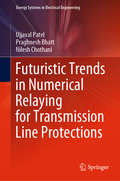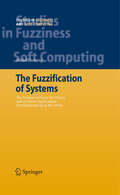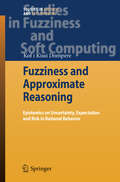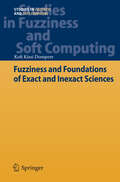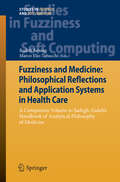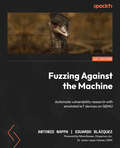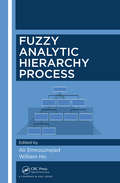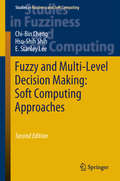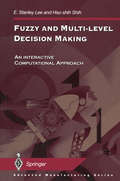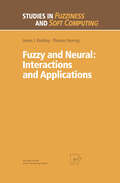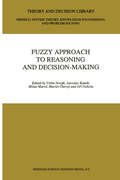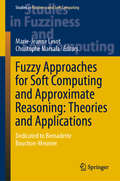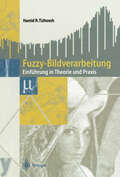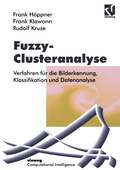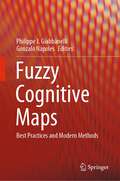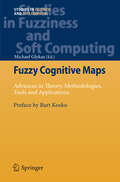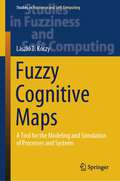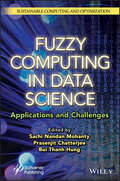- Table View
- List View
Futuristic Trends in Numerical Relaying for Transmission Line Protections (Energy Systems in Electrical Engineering)
by Ujjaval Patel Praghnesh Bhatt Nilesh ChothaniThis book presents the state-of-the-art approach for transmission line protection schemes for smart power grid. It provides a comprehensive solution for real-time development of numerical relaying schemes for future power grids which can minimize cascade tripping and widespread blackout problems prevailing all around the world. The book also includes the traditional approach for transmission line protection along with issues and challenges in protection philosophy. It highlights the issues for sheltering power grid from unwanted hazards with very fundamental approach. The book follows a step-by-step approach for resolving critical issues like high impedance faults, power swing detection and auto-reclosing schemes with adaptive protection process. The book also covers the topic of hardware solution for real-time implementation of auto-reclosing scheme for transmission line protection schemes along with comparative analysis with the recently developed analytical approach such as Artificial Neural Network (ANN), Support Vector Machine (SVM) and other machine learning algorithms. It will be useful to researchers and industry professionals and students in the fields of power system protection.
The Fuzzification of Systems: The Genesis of Fuzzy Set Theory and its Initial Applications - Developments up to the 1970s (Studies in Fuzziness and Soft Computing #216)
by Rudolf SeisingToday, Fuzzy Set Theory is the core discipline of so-called ‘soft’ computing, and provides new impetus for research in the field of artificial intelligence. In this fascinating book, the history of Fuzzy Set Theory and the ways it was first used are incorporated into the history of 20th century science and technology. Influences from philosophy, system theory and cybernetics stemming from the earliest part of the 20th century are considered alongside those of communication and control theory from mid-century.
Fuzziness and Approximate Reasoning: Epistemics on Uncertainty, Expectation and Risk in Rational Behavior (Studies in Fuzziness and Soft Computing #237)
by Kofi Kissi DompereWe do not perceive the present as it is and in totality, nor do we infer the future from the present with any high degree of dependability, nor yet do we accurately know the consequences of our own actions. In addition, there is a fourth source of error to be taken into account, for we do not execute actions in the precise form in which they are imaged and willed. Frank H. Knight [R4.34, p. 202] The “degree” of certainty of confidence felt in the conclusion after it is reached cannot be ignored, for it is of the greatest practical signi- cance. The action which follows upon an opinion depends as much upon the amount of confidence in that opinion as it does upon fav- ableness of the opinion itself. The ultimate logic, or psychology, of these deliberations is obscure, a part of the scientifically unfathomable mystery of life and mind. Frank H. Knight [R4.34, p. 226-227] With some inaccuracy, description of uncertain consequences can be classified into two categories, those which use exclusively the language of probability distributions and those which call for some other principle, either to replace or supplement.
Fuzziness and Foundations of Exact and Inexact Sciences (Studies in Fuzziness and Soft Computing #290)
by Kofi Kissi DompereThe monograph is an examination of the fuzzy rational foundations of the structure of exact and inexact sciences over the epistemological space which is distinguished from the ontological space. It is thus concerned with the demarcation problem. It examines exact science and its critique of inexact science. The role of fuzzy rationality in these examinations is presented. The driving force of the discussions is the nature of the information that connects the cognitive relational structure of the epistemological space to the ontological space for knowing. The knowing action is undertaken by decision-choice agents who must process information to derive exact-inexact or true-false conclusions. The information processing is done with a paradigm and laws of thought that constitute the input-output machine. The nature of the paradigm selected depends on the nature of the information structure that is taken as input of the thought processing. Generally, the information structure received from the ontological space is defective from the simple principles of acquaintances and the limitations of cognitive agents operating in the epistemological space. How then do we arrive and claim exactness in our knowledge-production system? The general conclusion of this book is that the conditions of the fuzzy paradigm with its laws of thought and mathematics present a methodological unity of exact and inexact sciences where every zone of thought has fuzzy covering.
Fuzziness and Medicine: A Companion Volume to Sadegh-Zadeh’s Handbook of Analytical Philosophy of Medicine (Studies in Fuzziness and Soft Computing #302)
by Rudolf Seising Marco Elio TabacchiThis book is a collection of contributions written by philosophers and scientists active in different fields, such as mathematics, logics, social sciences, computer sciences and linguistics. They comment on and discuss various parts of and subjects and propositions introduced in the Handbook of Analytical Philosophy of Medicine from Kadem Sadegh-Zadeh, published by Springer in 2012. This volume reports on the fruitful exchange and debate that arose in the fuzzy community upon the publication of the Handbook. This was not only very much appreciated by the community but also seen as a critical starting point for beginning a new discussion. The results of this discussion, which involved many different perspectives from science and the humanities and was warmly encouraged by Kadem Sadegh-Zadeh himself, are accurately reported in this volume, which is intended to be a critical companion to Kadem Sadegh-Zadeh´s handbook. Rudolf Seising is currently an adjunct researcher at the European Centre for Soft Computing in Mieres, Asturias (Spain) and a college lecturer at the Faculty of History and Arts, at the Ludwig Maximilians University of Munich (Germany). Marco Elio Tabacchi is currently the Scientific Director of the Italian National Research & Survey Organization Demopolis, and a research assistant in the Soft Computing Group at University of Palermo (Italy).
Fuzzing Against The Machine: Automate Vulnerability Research With Emulated Iot Devices On Qemu
by Antonio Nappa Eduardo Blazquez Eduardo Blazquez MateosFuzzing Against the Machine: Automate Vulnerability Research With Emulated Iot Devices On Qemu
by Antonio Nappa and Eduardo BlázquezAutomate vulnerability research with emulated IoT devices on QEMU
Fuzzy Analytic Hierarchy Process
by Ali Emrouznejad William HoThis book is the first in the literature to present the state of the art and some interesting and relevant applications of the Fuzzy Analytic Hierarchy Process (FAHP). The AHP is a conceptually and mathematically simple, easily implementable, yet extremely powerful tool for group decision making and is used around the world in a wide variety of decision situations, in fields such as government, business, industry, healthcare, and education. The aim of this book is to study various fuzzy methods for dealing with the imprecise and ambiguous data in AHP. Features: First book available on FAHP. Showcases state-of-the-art developments. Contains several novel real-life applications. Provides useful insights to both academics and practitioners in making group decisions under uncertainty This book provides the necessary background to work with existing fuzzy AHP models. Once the material in this book has been mastered, the reader will be able to apply fuzzy AHP models to his or her problems for making decisions with imprecise data.
Fuzzy Analytic Hierarchy Process
by Ali Emrouznejad William HoThis book is the first in the literature to present the state of the art and some interesting and relevant applications of the Fuzzy Analytic Hierarchy Process (FAHP). The AHP is a conceptually and mathematically simple, easily implementable, yet extremely powerful tool for group decision making and is used around the world in a wide variety of decision situations, in fields such as government, business, industry, healthcare, and education. The aim of this book is to study various fuzzy methods for dealing with the imprecise and ambiguous data in AHP. Features: First book available on FAHP. Showcases state-of-the-art developments. Contains several novel real-life applications. Provides useful insights to both academics and practitioners in making group decisions under uncertainty This book provides the necessary background to work with existing fuzzy AHP models. Once the material in this book has been mastered, the reader will be able to apply fuzzy AHP models to his or her problems for making decisions with imprecise data.
Fuzzy and Multi-Level Decision Making: Soft Computing Approaches (Studies in Fuzziness and Soft Computing #368)
by Chi-Bin Cheng Hsu-Shih Shih E. Stanley LeeThis book offers a comprehensive overview of cutting-edge approaches for decision-making in hierarchical organizations. It presents soft-computing-based techniques, including fuzzy sets, neural networks, genetic algorithms and particle swarm optimization, and shows how these approaches can be effectively used to deal with problems typical of this kind of organization. After introducing the main classical approaches applied to multiple-level programming, the book describes a set of soft-computing techniques, demonstrating their advantages in providing more efficient solutions to hierarchical decision-making problems compared to the classical methods. Based on the book Fuzzy and Multi-Level Decision Making (Springer, 2001) by Lee E.S and Shih, H., this second edition has been expanded to include the most recent findings and methods and a broader spectrum of soft computing approaches. All the algorithms are presented in detail, together with a wealth of practical examples and solutions to real-world problems, providing students, researchers and professionals with a timely, practice-oriented reference guide to the area of interactive fuzzy decision making, multi-level programming and hierarchical optimization.
Fuzzy and Multi-Level Decision Making: An Interactive Computational Approach (Advanced Manufacturing)
by E. Stanley Lee Hsu-shih ShihManagerial Decisions in hierarchy organizations, such as the various manufacturing and service companies, are difficult to formalize and even more difficult to optimize. By exploring the typical fuzziness, vagueness, or the "not-well-defined" nature of such organizations, this book presents the first comprehensive treatment of this difficult and practically important problem. The advantages of the proposed fuzzy interactive approach are that it significantly reduces computational requirements. Equally, the representation of the system is made more realistic through the recognition of the inherent fuzziness of such large organizations. Both the multi-ploy and the game-like decision making processes, also known as multi-level programming and the fuzzy interactive approach, are discussed in detail. The emphasis is on numerical algorithms and numerous examples are solved and compared. The concepts of fuzzy set and fuzzy linguistic representation, which form an integral part of any managerial decision, are also discussed.
Fuzzy and Neural: Interactions and Applications (Studies in Fuzziness and Soft Computing #25)
by James J. Buckley Thomas FeuringThe primary purpose of this book is to present information about selected topics on the interactions and applications of fuzzy + neural. Most of the discussion centers around our own research in these areas. Fuzzy + neural can mean many things: (1) approximations between fuzzy systems and neu ral nets (Chapter 4); (2) building hybrid neural nets to equal fuzzy systems (Chapter 5); (3) using neura.l nets to solve fuzzy problems (Chapter 6); (4) approximations between fuzzy neural nets and other fuzzy systems (Chap ter 8); (5) constructing hybrid fuzzy neural nets for certain fuzzy systems (Chapters 9, 10); or (6) computing with words (Chapter 11). This book is not intend to be used primarily as a text book for a course in fuzzy + neural because we have not included problems at the end of each chapter, we have omitted most proofs (given in the references), and we have given very few references. We wanted to keep the mathematical prerequisites to a minimum so all longer, involved, proofs were omitted. Elementary dif ferential calculus is the only prerequisite needed since we do mention partial derivatives once or twice.
Fuzzy and Rough Techniques in Medical Diagnosis and Medication (Studies in Fuzziness and Soft Computing #212)
by Elisabeth Rakus-AnderssonIn the late eighties of the twentieth century I encountered a paper referring to mathematics dealing with imprecision applied to medical diagnosis. I was working in the area of medical statistics at that time, and obviously I was interested in the contents of the paper. After I had read it I became fascinated by new possibilities of medical data interpretation and processing proposed by the author. The new world of fuzziness, originated by Professor Lotfi Zadeh, seemed to open up to me and I started reading all accessible material about fuzzy set theory. Many years have passed since then. We are now living in the information so- ety and we do not experience troubles in reaching scientific material. Lately I have read many papers and books about treating medical tasks solved by using fuzzy ideas. I am still keen on tracing applications in medicine, and by myself I have been contributing to some concepts in this subject that has motivated me to p- pare my own book. The objective of writing such a book has been a little parti- lar, namely, I have intended to present the subject of fuzzy tools and techniques in medicine for eventual users. These, maybe representatives of medical or phar- cological staffs, are not expected to possess a large amount of mathematical knowledge.
Fuzzy Applications in Industrial Engineering (Studies in Fuzziness and Soft Computing #201)
by Cengiz KahramanAfter an introductory chapter explaining recent applications of fuzzy sets in IE, this book explores the seven major areas of IE to which fuzzy set theory can contribute: Control and Reliability, Engineering Economics and Investment Analysis, Group and Multi-criteria Decision-making, Human Factors Engineering and Ergonomics, Manufacturing Systems and Technology Management, Optimization Techniques, and Statistical Decision-making. Under these major areas, every chapter includes didactic numerical applications.
Fuzzy Approach to Reasoning and Decision-Making: Selected Papers of the International Symposium held at Bechyně, Czechoslovakia, 25-29 June 1990 (Theory and Decision Library D: #8)
by Vilém Novák Jirí Nekola Jaroslav Ramík Milan Mares Martin CernýSelected Papers of the International Symposium held at Bechyne, June 25-29, 1990
Fuzzy Approaches for Soft Computing and Approximate Reasoning: Dedicated to Bernadette Bouchon-Meunier (Studies in Fuzziness and Soft Computing #394)
by Marie-Jeanne Lesot Christophe MarsalaThis book gathers cutting-edge papers in the area of Computational Intelligence, presented by specialists, and covering all major trends in the research community in order to provide readers with a rich primer. It presents an overview of various soft computing topics and approximate reasoning-based approaches, both from theoretical and applied perspectives. Numerous topics are covered: fundamentals aspects of fuzzy sets theory, reasoning approaches (interpolative, analogical, similarity-based), decision and optimization theory, fuzzy databases, soft machine learning, summarization, interpretability and XAI. Moreover, several application-based papers are included, e.g. on image processing, semantic web and intelligent tutoring systems. This book is dedicated to Bernadette Bouchon-Meunier in honor of her achievements in Computational Intelligence, which, throughout her career, have included profuse and diverse collaborations, both thematically and geographically.
Fuzzy-Bildverarbeitung: Einführung in Theorie und Praxis
by Hamid R. TizhooshIn den letzten Jahren hat die Fuzzy-Logik auch im Bereich der Mustererkennung Einzug gehalten. Das Buch befaßt sich mit dem Einsatz von Fuzzy-Methoden in der digitalen Bildverarbeitung. Es führt Schritt für Schritt in die Theorie und Praxis der Fuzzy-Bildverarbeitung ein und stellt neue Konzepte, Definitionen und Algorithmen vor. Anhand zahlreicher Beispiele wird die Theorie unmittelbar in die Praxis umgesetzt.Das Buch wendet sich an alle Wissenschaftler, Ingenieure und Studierenden, die in den Bereichen der Fuzzy-Logik oder der Bildverarbeitung aktiv sind. Vorausgesetzt wird nur eine gewisse Vertrautheit mit Bildverarbeitung; die Grundlagen der Fuzzy-Logik werden in den ersten Kapiteln ausführlich behandelt.
Fuzzy Chaotic Systems: Modeling, Control, and Applications (Studies in Fuzziness and Soft Computing #199)
by Zhong LiThis book presents the fundamental concepts of fuzzy logic and fuzzy control, chaos theory and chaos control. It also provides a definition of chaos on the metric space of fuzzy sets. The book raises many questions and generates a great potential to attract more attention to combine fuzzy systems with chaos theory. In this way it contains important seeds for future scientific research and engineering applications.
Fuzzy Choice Functions: A Revealed Preference Approach (Studies in Fuzziness and Soft Computing #214)
by Irina GeorgescuThis book extends the theory of revealed preference to fuzzy choice functions, providing applications to multicriteria decision making problems. The main topics of revealed preference theory are treated in the framework of fuzzy choice functions. New topics, such as the degree of dominance and similarity of vague choices, are developed. The results are applied to economic problems where partial information and human subjectivity involve vague choices and vague preferences.
Fuzzy-Clusteranalyse: Verfahren für die Bilderkennung, Klassifizierung und Datenanalyse (Computational Intelligence)
by Frank Höppner Frank Klawonn Rudolf KruseDieses Buch ist das Standardwerk zu einem neuen Bereich der angewandten Fuzzy-Technologie, der Fuzzy-Clusteranalyse. Diese beinhaltet Verfahren der Mustererkennung zur Gruppierung und Strukturierung von Daten. Dabei werden im Gegensatz zu klassischen Clustering-Techniken die Daten nicht eindeutig zu Klassen zugeordnet, sondern Zugehörigkeitsgrade bestimmt, so daß die Fuzzy-Verfahren robust gegenüber gestörten oder verrauschten Daten sind und fließende Klassenübergänge handhaben können. Dieses Werk gibt eine methodische Einführung in die zahlreichen Fuzzy-Clustering-Algorithmen mit ihren Anwendungen in den Bereichen Datenanalyse, Erzeugung von Regeln für Fuzzy-Regler, Klassifikations- und Approximationsprobleme sowie eine ausführliche Darstellung des Shell-Clustering zur Erkennung von geometrischen Konturen in Bildern.
Fuzzy Cognitive Maps: Best Practices and Modern Methods
by Philippe J. Giabbanelli Gonzalo NápolesThis book starts with the rationale for creating an FCM by contrast to other techniques for participatory modeling, as this rationale is a key element to justify the adoption of techniques in a research paper. Fuzzy cognitive mapping is an active research field with over 20,000 publications devoted to externalizing the qualitative perspectives or “mental models” of individuals and groups. Since the emergence of fuzzy cognitive maps (FCMs) back in the 80s, new algorithms have been developed to reduce bias, facilitate the externalization process, or efficiently utilize quantitative data via machine learning. It covers the development of an FCM with participants through a traditional in-person setting, drawing from the experience of practitioners and highlighting solutions to commonly encountered challenges. The book continues with introducing principles of simulations with FCMs as a tool to perform what-if scenario analysis, while extending those principles to more elaborated simulation scenarios where FCMs and agent-based modeling are combined. Once an FCM model is obtained, the book then details the analytical tools available for practitioners (e.g., to identify the most important factors) and provides examples to aid in the interpretation of results. The discussion concerning relevant extensions is equally pertinent, which are devoted to increasing the expressiveness of the FCM formalism in problems involving uncertainty. The last four chapters focus on building FCM models from historical data. These models are typically needed when facing multi-output prediction or pattern classification problems. In that regard, the book smoothly guides the reader from simple approaches to more elaborated algorithms, symbolizing the noticeable progress of this field in the last 35 years. Problems, recent references, and functional codes are included in each chapter to provide practice and support further learning from practitioners and researchers.
Fuzzy Cognitive Maps: Advances in Theory, Methodologies, Tools and Applications (Studies in Fuzziness and Soft Computing #247)
by Michael GlykasThis important edited volume is the first such book ever published on fuzzy cognitive maps (FCMs). Professor Michael Glykas has done an exceptional job in bringing together and editing its seventeen chapters. The volume appears nearly a quarter century after my original article “Fuzzy Cognitive Maps” appeared in the International Journal of Man-Machine Studies in 1986. The volume accordingly reflects many years of research effort in the development of FCM theory and applications—and portends many more decades of FCM research and applications to come. FCMs are fuzzy feedback models of causality. They combine aspects of fuzzy logic, neural networks, semantic networks, expert systems, and nonlinear dynamical systems. That rich structure endows FCMs with their own complexity and lets them apply to a wide range of problems in engineering and in the soft and hard sciences. Their partial edge connections allow a user to directly represent causality as a matter of degree and to learn new edge strengths from training data. Their directed graph structure allows forward or what-if inferencing. FCM cycles or feedback paths allow for complex nonlinear dynamics. Control of FCM nonlinear dynamics can in many cases let the user encode and decode concept patterns as fixed-point attractors or limit cycles or perhaps as more exotic dynamical equilibria. These global equilibrium patterns are often “hidden” in the nonlinear dynamics. The user will not likely see these global patterns by simply inspecting the local causal edges or nodes of large FCMs.
Fuzzy Cognitive Maps: A Tool for the Modeling and Simulation of Processes and Systems (Studies in Fuzziness and Soft Computing #427)
by László T. KóczyThis book is considered as a monograph but also as a potential textbook for graduate students, focusing on the application of FCMs for modelling and analysing the behaviour of multicomponent systems. In the last two decades, no monograph or textbook has been published on the topic Fuzzy Cognitive Maps (FCM), so this new book is definitely filling a gap in the literature of computational intelligence. The book is built up didactically, the novel results in the field being presented in the way of starting with two real-life case studies, one in the area of waste management, while the other one in modelling bank management systems. In both cases, the book starts with explaining the applied problem and then presenting how the model construction is done and what problems emerge when attempts are made for applying directly earlier results on FCM modelling. In the first case study, the problem of the oversimplification leads to inadequacy of the model, and then it is shown how new, much finer models can be built up based on expert domain knowledge. Then, the new problem of losing transparency and interpretability emerges, and as a solution, a new algorithm family is proposed that reduces FCMs to fewer components, while preserving the essential characteristics of the original model.The second case study raises the problems of stability and sensitivity of FCMs, especially, considering that expert knowledge is often uncertain and subjective. The new results summarised in the book target the questions of how to ascertain whether an FCM is converging to one or several fixed point attractors, whether there is a bifurcation when parameters are changing, etc. Both problems deal with the ultimate question whether the system modelled is stable and sustainable.
Fuzzy Computing in Data Science: Applications and Challenges (Smart and Sustainable Intelligent Systems)
by Sachi Nandan Mohanty Prasenjit Chatterjee Bui Thanh HungFUZZY COMPUTING IN DATA SCIENCE This book comprehensively explains how to use various fuzzy-based models to solve real-time industrial challenges. The book provides information about fundamental aspects of the field and explores the myriad applications of fuzzy logic techniques and methods. It presents basic conceptual considerations and case studies of applications of fuzzy computation. It covers the fundamental concepts and techniques for system modeling, information processing, intelligent system design, decision analysis, statistical analysis, pattern recognition, automated learning, system control, and identification. The book also discusses the combination of fuzzy computation techniques with other computational intelligence approaches such as neural and evolutionary computation. Audience Researchers and students in computer science, artificial intelligence, machine learning, big data analytics, and information and communication technology.
Fuzzy Computing in Data Science: Applications and Challenges (Smart and Sustainable Intelligent Systems)
by Sachi Nandan Mohanty Prasenjit Chatterjee Bui Thanh HungFUZZY COMPUTING IN DATA SCIENCE This book comprehensively explains how to use various fuzzy-based models to solve real-time industrial challenges. The book provides information about fundamental aspects of the field and explores the myriad applications of fuzzy logic techniques and methods. It presents basic conceptual considerations and case studies of applications of fuzzy computation. It covers the fundamental concepts and techniques for system modeling, information processing, intelligent system design, decision analysis, statistical analysis, pattern recognition, automated learning, system control, and identification. The book also discusses the combination of fuzzy computation techniques with other computational intelligence approaches such as neural and evolutionary computation. Audience Researchers and students in computer science, artificial intelligence, machine learning, big data analytics, and information and communication technology.
